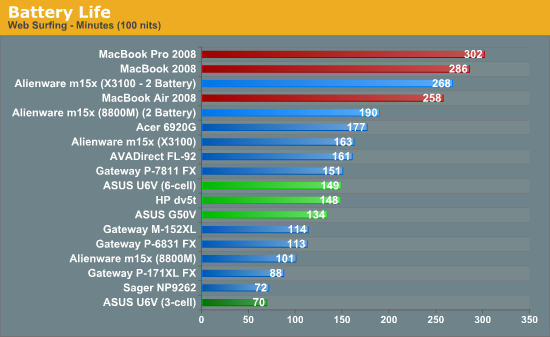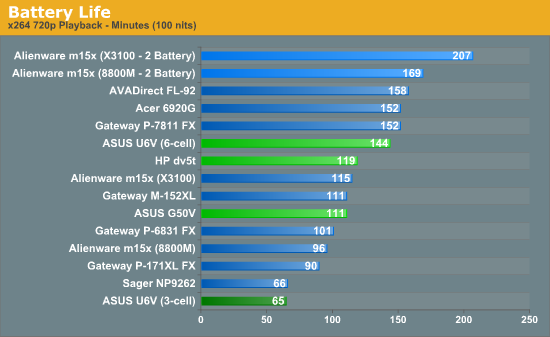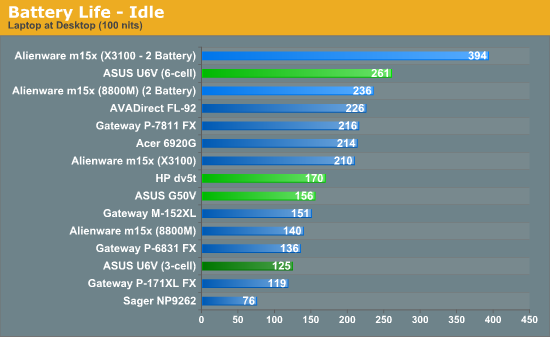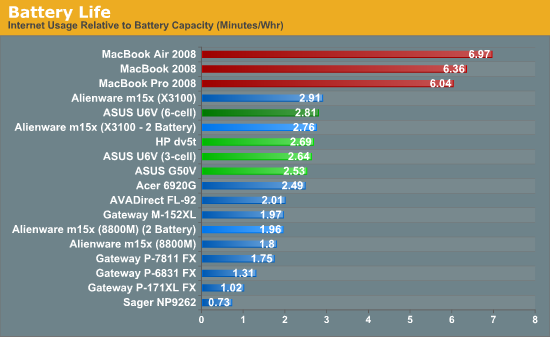Battery Life
Gaming and application performance is all well and good, but many users looking at notebooks really care about battery life. Let's see how these laptops fare in comparison to the other notebooks we've tested, although quite a few of the notebooks we tested previously are gaming models so battery life is lower on those models.
For battery life testing, we run all laptops at around 100 nits brightness. If you choose to run your LCD at maximum brightness, you may lose anywhere from 10 to 60 minutes depending on the laptop - the latter is mostly for ultra-mobile options while the former is for gaming notebooks. We run four different battery life scenarios: Internet surfing (load several webpages using the wireless adapter every minute until the battery dies), DVD playback, x264 playback, and idle (maximum) battery life. For x264 playback, we copy a 720p file to the hard drive and loop playback using Windows Media Player Classic. We will also include battery life results for Blu-ray playback in the DVD chart where appropriate. We've also included web surfing results (and DVD for the MBP) for the latest Apple MacBooks as a point of reference. (Yeah, it isn't pretty….)




Considering the different battery sizes, it's not too surprising to see the midrange notebooks surpassing most of the other laptops. Unfortunately for the Windows users of the world, the MacBooks running OS X all severely trounce what the PC notebooks can provide; the best the PC can muster is the Alienware m15x with two batteries running on the integrated X3100 graphics - hardly a fair fight, considering the total battery capacity is about twice what you find in the MacBook Pro. Also rather shocking is that the U6V really doesn't do as well as you would expect, given its smaller size. If we remove the dual-battery Alienware from the list (and ignore the MacBooks), the U6V is beat by several of the other notebooks… with one exception. Oddly enough, in idle battery life the U6V shows that it can offer up to 15% more battery life than the next closest competitor.
Again, the big problem is that in similar testing Apple's MacBook and MacBook Pro provide an almost untouchable amount of battery life. To give you a true apples-to-Apples comparison, we've calculated the amount of battery life you get per Whr (Watt Hour) of battery capacity:

If the earlier battery results made the Vista systems look bad, this graph is even worse! The MacBook Pro offers over six minutes of battery life per Whr, and the best Vista laptop we've tested posts a paltry score of less than three minutes per Whr. We mentioned this earlier in our MacBook 2008 review, but the results here are beyond terrible. Setting the power scheme to "Battery Saver" instead of "Balanced" (the default in our testing) improved battery life by a few percent, which is still a far cry from what Apple is managing under OS X. The million dollar question of course is whether this is a flaw with Vista, or just something that the notebooks we've tested are not handling properly. Until we can actually find a Vista PC that can come close to six minutes per Whr, however, we're pretty confident in saying that the OS has a lot more to do with it than anything else.
Incidentally, we did run a quick battery life test under Express Gate (powered by SplashTop) on both the ASUS notebooks. That environment is based on Linux, and for ease of testing we decided to just go with a near-idle test (we set up another PC to ping each laptop once per minute to determine when power actually failed). It was pretty obvious that Express Gate isn't even remotely power optimized, as battery life was only 92 minutes on the G50V and 144 minutes on the U6V; it looks like the CPU ran at maximum speed throughout the test.










27 Comments
View All Comments
JarredWalton - Friday, October 24, 2008 - link
I chatted a bunch with ASUS on this; there was some confusion so I may have ended up with the wrong conclusion. (Yeah, marketing wasn't positive on the specs, and engineering didn't ever pass on the exact details.) I actually had a paragraph detailing the differences between the 9800M GTS and this supposed 9800M GS. Since I don't have one in my hands, I can't say one way or the other with certainty.The worst case would appear to be clock speeds equal to that of the 8800M GTS (500 core instead of 600 core on the 9800M GTS), which is still going to be a lot faster than these other notebooks. Since it's also limited to 1366x768, gaming performance should be no problem at native res... but there's a lot of headroom left untapped. Certainly, gaming performance won't be lower than the G50V tested here, unless the game happens to be CPU limited.
Enrox - Friday, October 24, 2008 - link
Take a look at the Gateway P-7811 battery's life: it's about 150 minutes regarless the task (DVD playback, web surfing, H.264 playback).That to me says only one thing: no power management in place.
Is that a Vista issue or a BIOS issue?
JarredWalton - Friday, October 24, 2008 - link
Oh, the P-7811 is definitely doing *something* - though idle battery life is lower than I'd expect relative to the others. Actually, I think it's more that the P-7811 is doing quite well in other tasks. Remember: 17" 1920x1200 LCD, 7200 RPM HDD, and a 9800M GTS put it at a much higher power envelope than most of the other laptops. Relative to the P-6831 and m15x, the results seem to be right where you'd expect. If only Gateway had implemented Hybrid Power....jonmcc33 - Friday, October 24, 2008 - link
Did you verify that with the Power Saver setting that EIST was working properly? Use CPU-Z or similar to see if the clock speed of the FSB and CPU does change as it should. Check the BIOS settings as well.CU - Friday, October 24, 2008 - link
Yes it would be interesting to know what the cpu, gpu, fsb, and ram clocks are at when in power saving mode for Vista and OSX.JarredWalton - Friday, October 24, 2008 - link
CPU speed drops to a 6X multiplier, so at least that aspect is working. Looking at the voltages (according to CPU-Z), they're all at 1.083V except for the G50V, which runs at 1.338V most of the time. (I'm still trying to figure out what's going on there and will update when I know more.) I'm not as concerned with G50V battery life, though, since it's in a different class of performance and size; it's the U6V and similar notebooks that need to do a lot better.Regarding RAM, GPU, and FSB, the FSB stays locked at the base speed - 1066 MHz on the Centrino 2 notebooks. RAM likewise stays at a set speed, in this case 800 MHz. 2D GPU clocks (according to GPU-Z) are 169 MHz core, 200 MHz (100 base) VRAM on all three of these notebooks. GPU-Z also reports a memory clock of 800 MHz (400 base) for the HP dv5t, which seems wrong - I though the 9600M GT was supposed to be much faster RAM, but apparently not.
JarredWalton - Friday, October 24, 2008 - link
Update: The G50V was back on "High Performance" mode after rebooting (an issue with some of the ASUS software). Setting it back to "Balanced" or "Power Saver" dropped the CPU voltage to the expected voltage - though still slightly higher than the others at 1.063V.fabarati - Friday, October 24, 2008 - link
Asus is known for their crappy batterylife in the latest generation. When compared to equal or even better specced laptops, they fall flat on the ground. It's probably because of bad ACPI coding. My F8Sa has worse battery life than my old A8Js, despite having less powerhungry parts. And the A8Js had mediocre batterylife (I reached about 3½ hours, with hardware disabled). I can barely break 2 hours, and that's when I disable hardware.The HP DV5 seems to suffer from the same issue, at least that's the conclusion we came to when it was tested by NBR.
JarredWalton - Friday, October 24, 2008 - link
I haven't tested a comprehensive selection of laptops by any means, but if you look at the specs for the various laptops and the resulting Minutes/Whr chart you can see that if this is bad ACPI coding the practice extends far beyond just ASUS and HP. If the MacBook Pro was around 3 or 4 Min/Whr, I'd think maybe it was just some fine tuning that was missing, but it's still literally double what the closest tested Vista laptop managed.The best result I've personally seen on Vista to date is the http://www.anandtech.com/mobile/showdoc.aspx?i=328...">ASUS U2E, which manages 3.72 Min/Whr with the 86.5 Whr battery. That's a lot closer than the other laptops, but keep in mind that has a U7500 CPU (10W max TDP), X3100 IGP, and an SSD, plus an 11.1" LED LCD.
Another 15.4" laptop I'm currently testing with T7250 and X4500 graphics (plus 4GB RAM, 250GB 5400RPM HDD) manages 4.18 Min/Whr, which is closer to Apple. Still, that's a 50% advantage for the MacBook, so it's not really *that* close. (It gets 204 minutes of battery life in our web surfing test.)
nizanh - Friday, October 24, 2008 - link
Can't you just install Vista on one of the MacBooks?Sounds to me like the best testing methodology.